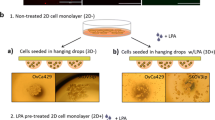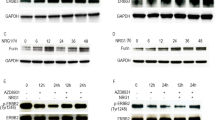Abstract
Ovarian cancer is a highly metastatic disease. Lysophosphatidic acid (LPA) levels are elevated in ascites from ovarian cancer patients, but its potential role in ovarian cancer metastasis has just begun to be revealed. In this work, we show that LPA stimulates invasion of primary ovarian cancer cells, but not ovarian epithelial or borderline ovarian tumor cells, although these benign cells indeed respond to LPA in cell migration. We have found that LPA downregulates tissue inhibitor of metalloproteinases (TIMPs). TIMP2 and TIMP3 play functional role in LPA-induced invasion as negative regulators. Gi protein, phosphatidylinositol-3 kinase (PI3K), p38 mitogen-activated protein kinase (MAPK), cytosolic phospholipase A2 and urokinase type plasminogen activator (uPA) are required for LPA-induced cells invasion. TIMP3 may affect two independent downstream targets, vascular endothelial growth factor receptor and p38 MAPK. In vivo, LPA stimulates tumor metastasis in an orthotopic ovarian tumor model, which can be inhibited by a PI3K inhibitor, LY294002. In summary, LPA is likely a key component for promoting ovarian metastasis in vivo. LPA downregulates TIMP3, which may have targets other than metalloproteinases. Our in vivo metastasis mouse model is useful for studying the efficacy of therapeutic regimes of ovarian cancer.
This is a preview of subscription content, access via your institution
Access options
Subscribe to this journal
Receive 50 print issues and online access
$259.00 per year
only $5.18 per issue
Buy this article
- Purchase on Springer Link
- Instant access to full article PDF
Prices may be subject to local taxes which are calculated during checkout




Similar content being viewed by others
References
Baudhuin L, Cristina KL, Lu J, Xu Y . (2002). Akt activation induced by lysophosphatidic acid and sphingosine-1-phosphate requires both mitogen-activated protein kinase kinase and p38 mitogen-activated protein kinase and is cell-line specific. Mol Pharmacol 62: 660–671.
Bian D, Mahanivong C, Yu J, Frisch SM, Pan ZK, Ye RD et al. (2006). The G12/13-RhoA signaling pathway contributes to efficient lysophosphatidic acid-stimulated cell migration. Oncogene 25: 2234–2244.
Bian D, Su S, Mahanivong C, Cheng RK, Han Q, Pan ZK et al. (2004). Lysophosphatidic acid stimulates ovarian cancer cell migration via a Ras-MEK kinase 1 pathway. Cancer Res 64: 4209–4217.
Cai W, Song JD . (2002). Expression of matrix metalloproteinase and tissue inhibitors in ovarian tumors. Ai Zheng 21: 91–94.
Casey RC, Koch KA, Oegema Jr TR, Skubitz KM, Pambuccian SE, Grindle SM et al. (2003). Establishment of an in vitro assay to measure the invasion of ovarian carcinoma cells through mesothelial cell monolayers. Clin Exp Metast 20: 343–356.
Eder AM, Sasagawa T, Mao M, Aoki J, Mills GB . (2000). Constitutive and lysophosphatidic acid (LPA)-induced LPA production: role of phospholipase D and phospholipase A2. Clin Cancer Res 6: 2482–2491.
Fang X, Schummer M, Mao M, Yu S, Tabassam FH, Swaby R et al. (2002). Lysophosphatidic acid is a bioactive mediator in ovarian cancer. Biochim Biophys Acta 1582: 257–264.
Fang X, Yu S, Bast RC, Liu S, Xu HJ, Hu SX et al. (2004). Mechanisms for lysophosphatidic acid-induced cytokine production in ovarian cancer cells. J Biol Chem 279: 9653–9661.
Fishman DA, Liu Y, Ellerbroek SM, Stack MS . (2001). Lysophosphatidic acid promotes matrix metalloproteinase (MMP) activation and MMP-dependent invasion in ovarian cancer cells. Cancer Res 61: 3194–3199.
Hartsough MT, Steeg PS . (2000). Nm23/nucleoside diphosphate kinase in human cancers. J Bioenerg Biomembr 32: 301–308.
Hennessy BT, Smith DL, Ram PT, Lu Y, Mills GB . (2005). Exploiting the PI3K/AKT pathway for cancer drug discovery. Nat Rev Drug Discov 4: 988–1004.
Hu L, Hofmann J, Lu Y, Mills GB, Jaffe RB . (2002). Inhibition of phosphatidylinositol 3′-kinase increases efficacy of paclitaxel in in vitro and in vivo ovarian cancer models. Cancer Res 62: 1087–1092.
Hu L, Zaloudek C, Mills GB, Gray J, Jaffe RB . (2000). In vivo and in vitro ovarian carcinoma growth inhibition by a phosphatidylinositol 3-kinase inhibitor (LY294002). Clin Cancer Res 6: 880–886.
Hu XX, Li L, Li DR, Zhang W, Cheng XQ, Zhang JQ et al. (2004). Expression of matrix metalloproteinases-9,2,7 and tissue inhibitor of metalloproteinases-1,2,3 mRNA in ovarian tumors and their clinical significance. Ai Zheng 23: 1194–1198.
Hu YL, Tee MK, Goetzl EJ, Auersperg N, Mills GB, Ferrara N et al. (2001). Lysophosphatidic acid induction of vascular endothelial growth factor expression in human ovarian cancer cells. J Natl Cancer Inst 93: 762–768.
Kim KS, Sengupta S, Berk M, Kwak YG, Escobar P, Belinson J et al. (2006). Hypoxia enhances lysophosphatidic acid (LPA) responsiveness in ovarian cancer cells and LPA induces ovarian tumor metastasis in vivo. Cancer Res 66: 3006–3014.
Krol J, Kopitz C, Kirschenhofer A, Schmitt M, Magdolen U, Kruger A et al. (2003a). Inhibition of intraperitoneal tumor growth of human ovarian cancer cells by bi- and trifunctional inhibitors of tumor-associated proteolytic systems. Biol Chem 384: 1097–1102.
Krol J, Sato S, Rettenberger P, Assfalg-Machleidt I, Schmitt M, Magdolen V et al. (2003b). Novel bi- and trifunctional inhibitors of tumor-associated proteolytic systems. Biol Chem 384: 1085–1096.
Li H, Ye X, Mahanivong C, Bian D, Chun J, Huang S . (2005). Signaling mechanisms responsible for lysophosphatidic acid-induced urokinase plasminogen activator expression in ovarian cancer cells. J Biol Chem 280: 10564–10571.
Manenti L, Paganoni P, Floriani I, Landoni F, Torri V, Buda A et al. (2003). Expression levels of vascular endothelial growth factor, matrix metalloproteinases 2 and 9 and tissue inhibitor of metalloproteinases 1 and 2 in the plasma of patients with ovarian carcinoma. Eur J Cancer 39: 1948–1956.
Mills GB, Eder A, Fang X, Hasegawa Y, Mao M, Lu Y et al. (2002). Critical role of lysophospholipids in the pathophysiology, diagnosis, and management of ovarian cancer. Cancer Treat Res 107: 259–283.
Mills GB, Moolenaar WH . (2003). The emerging role of lysophosphatidic acid in cancer. Nat Rev Cancer 3: 582–591.
Munshi HG, Wu YI, Mukhopadhyay S, Ottaviano AJ, Sassano A, Koblinski JE et al. (2004). Differential regulation of membrane type 1-matrix metalloproteinase activity by ERK 1/2- and p38 MAPK-modulated tissue inhibitor of metalloproteinases 2 expression controls transforming growth factor-beta1-induced pericellular collagenolysis. J Biol Chem 279: 39042–39050 (E-pub 2004 Jul 9).
Pustilnik TB, Estrella V, Wiener JR, Mao M, Eder A, Watt MA et al. (1999). Lysophosphatidic acid induces urokinase secretion by ovarian cancer cells. Clin Cancer Res 5: 3704–3710.
Qian L, Xu Y, Hasegawa Y, Aoki J, Mills GB, Prestwich GD . (2003). Enantioselective responses to a phosphorothioate analogue of lysophosphatidic acid with LPA3 receptor-selective agonist activity. J Med Chem 46: 5575–5578.
Rauvala M, Puistola U, Turpeenniemi-Hujanen T . (2005). Gelatinases and their tissue inhibitors in ovarian tumors; TIMP-1 is a predictive as well as a prognostic factor. Gynecol Oncol 99: 656–663.
Ren J, Xiao YJ, Singh LS, Zhao X, Zhao Z, Feng L et al. (2006). Lysophosphatidic acid is constitutively produced by human peritoneal mesothelial cells and enhances adhesion, migration, and invasion of ovarian cancer cells. Cancer Res 66: 3006–3014.
Sakata K, Shigemasa K, Nagai N, Ohama K . (2000). Expression of matrix metalloproteinases (MMP-2, MMP-9, MT1-MMP) and their inhibitors (TIMP-1, TIMP-2) in common epithelial tumors of the ovary. Int J Oncol 17: 673–681.
Sawada K, Morishige K, Tahara M, Ikebuchi Y, Kawagishi R, Tasaka K et al. (2002). Lysophosphatidic acid induces focal adhesion assembly through Rho/Rho-associated kinase pathway in human ovarian cancer cells. Gynecol Oncol 87: 252–259.
Schwartz BM, Hong G, Morrison BH, Wu W, Baudhuin LM, Xiao YJ et al. (2001). Lysophospholipids increase interleukin-8 expression in ovarian cancer cells. Gynecol Oncol 81: 291–300.
Sengupta S, Wang Z, Tipps R, Xu Y . (2004). Biology of LPA in health and disease. Semin Cell Dev Biol 15: 503–512.
Sengupta S, Xiao YJ, Xu Y . (2003). A novel laminin-induced LPA autocrine loop in the migration of ovarian cancer cells. FASEB J 17: 1570–1572.
Seo DW, Li H, Guedez L, Wingfield PT, Diaz T, Salloum R et al. (2003). TIMP-2 mediated inhibition of angiogenesis: an MMP-independent mechanism. Cell 114: 171–180.
Shen Z, Belinson J, Morton RE, Xu Y, Xu Y . (1998). Phorbol 12-myristate 13-acetate stimulates lysophosphatidic acid secretion from ovarian and cervical cancer cells but not from breast or leukemia cells. Gynecol Oncol 71: 364–368.
So J, Navari J, Wang FQ, Fishman DA . (2004). Lysophosphatidic acid enhances epithelial ovarian carcinoma invasion through the increased expression of interleukin-8. Gynecol Oncol 95: 314–322.
So J, Wang FQ, Navari J, Schreher J, Fishman DA . (2005). LPA-induced epithelial ovarian cancer (EOC) in vitro invasion and migration are mediated by VEGF receptor-2 (VEGF-R2). Gynecol Oncol 97: 870–878.
Sugimoto N, Takuwa N, Yoshioka K, Takuwa Y . (2006). Rho-dependent, Rho kinase-independent inhibitory regulation of Rac and cell migration by LPA1 receptor in Gi-inactivated CHO cells. Exp Cell Res 312: 1899–1908.
Symowicz J, Adley BP, Woo MM, Auersperg N, Hudson LG, Stack MS . (2005). Cyclooxygenase-2 functions as a downstream mediator of lysophosphatidic acid to promote aggressive behavior in ovarian carcinoma cells. Cancer Res 65: 2234–2242.
Wang X, Wang E, Kavanagh JJ, Freedman RS . (2005). Ovarian cancer, the coagulation pathway, and inflammation. J Transl Med 3: 25.
Xiao Y, Chen Y, Kennedy AW, Belinson J, Xu Y . (2000). Evaluation of plasma lysophospholipids for diagnostic significance using electrospray ionization mass spectrometry (ESI-MS) analyses. Ann NY Acad Sci 905: 242–259.
Xiao YJ, Schwartz B, Washington M, Kennedy A, Webster K, Belinson J et al. (2001). Electrospray ionization mass spectrometry analysis of lysophospholipids in human ascitic fluids: comparison of the lysophospholipid contents in malignant vs nonmalignant ascitic fluids. Anal Biochem 290: 302–313.
Xu J, Lai YJ, Lin WC, Lin FT . (2004). TRIP6 enhances lysophosphatidic acid-induced cell migration by interacting with the lysophosphatidic acid 2 receptor. J Biol Chem 279: 10459–10468.
Xu Y, Fang XJ, Casey G, Mills GB . (1995a). Lysophospholipids activate ovarian and breast cancer cells. Biochem J 309 (Part 3): 933–940.
Xu Y, Gaudette DC, Boynton JD, Frankel A, Fang XJ, Sharma A et al. (1995b). Characterization of an ovarian cancer activating factor in ascites from ovarian cancer patients. Clin Cancer Res 1: 1223–1232.
Acknowledgements
We are grateful to Dr Samuel C Mok for his kind gift of the HOSE cells and for teaching us to culture primary ovarian tumor cells. We thank Drs Kevin Lynch and Timothy MacDonald (University of Virginia, Charlottesville, VA, USA) for providing us with VPC32301 and VPC32073 (antagonists of LPA receptors). We also thank Dr S Huang (The Scripps Research Institute) for the siRNA targeting to uPA. This work was supported in part by RO1 CA095042 and a grant from the Charlotte Geyer Foundation to YX.
Author information
Authors and Affiliations
Corresponding author
Additional information
Supplementary Information accompanies the paper on the Oncogene website (http://www.nature.com/onc).
Rights and permissions
About this article
Cite this article
Sengupta, S., Kim, K., Berk, M. et al. Lysophosphatidic acid downregulates tissue inhibitor of metalloproteinases, which are negatively involved in lysophosphatidic acid-induced cell invasion. Oncogene 26, 2894–2901 (2007). https://doi.org/10.1038/sj.onc.1210093
Received:
Revised:
Accepted:
Published:
Issue Date:
DOI: https://doi.org/10.1038/sj.onc.1210093
Keywords
This article is cited by
-
Potential interaction between lysophosphatidic acid and tumor-associated macrophages in ovarian carcinoma
Journal of Inflammation (2020)
-
Bithionol inhibits ovarian cancer cell growth In Vitro- studies on mechanism(s) of action
BMC Cancer (2014)
-
Ovarian cancer microenvironment: implications for cancer dissemination and chemoresistance acquisition
Cancer and Metastasis Reviews (2014)
-
The clinical significance and regulation mechanism of hypoxia-inducible factor-1 and miR-191 expression in pancreatic cancer
Tumor Biology (2014)
-
The role of LPA and YAP signaling in long-term migration of human ovarian cancer cells
Cell Communication and Signaling (2013)



